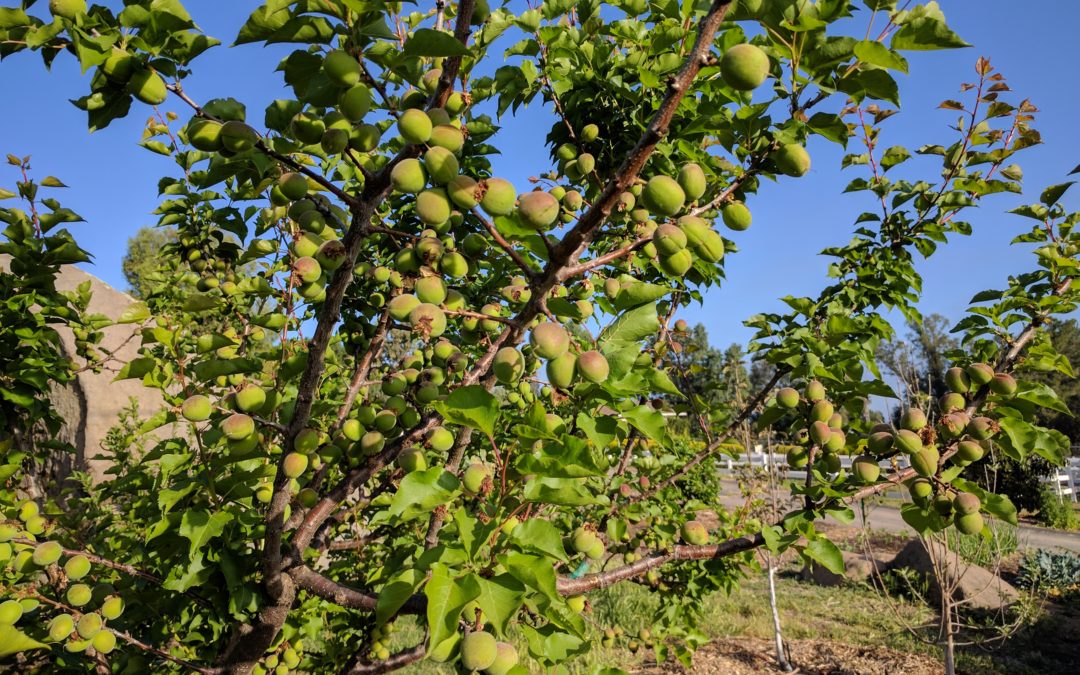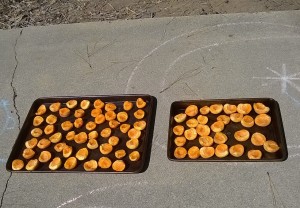The standard advice from the experts once again doesn’t align with my experience. This time it relates to the idea that thinning fruit will lead to larger fruit. From the horse’s mouth: “Thinning immature fruit at the appropriate time allows each remaining fruit to develop to its maximum size.”
Why? “Excessive fruit compete with each other for carbohydrates and remain small.”
Therefore, “All stone fruits (peaches, apricots, nectarines, cherries, plums, etc. ) require thinning.”
The horse is the University of California publication “Fruit Trees: Thinning Young Fruit.”
Until I learn otherwise, I follow the advice of the experts. So last year I thinned my apricot fruit precisely as they advised. The harvest was very satisfactory. But this year, just as an experiment, I didn’t thin. I wanted to see if the fruit would end up smaller at harvest time. The tree set a ton of fruit, more fruit than last year, but still I left them all, except for some fruit that weighed down the ends of a couple of thin branches and threatened to break them. The result? More fruit than my family and friends could eat, so many that I dried dozens of them, and yet they were the same size as last year. There was no difference in the size of the fruit at all.
My conclusion is that while there are other good reasons to thin fruit, the goal of increasing fruit size is not one of them — for Blenheim apricots anyway.
Thin fruit if they might break a small branch, thin fruit that are diseased or damaged, thin fruit that are too exposed to the sun, for example. But don’t thin fruit thinking that it is the way for “each remaining fruit to develop to its maximum size.”
You might also like to read:





Your experience is remarkable to me. So I am remarking. I tried both ways also and got smaller apricots when not thinned. I live in Orem, Utah and it may be because of the cold winters. I don’t know.
What I do know is that one year I counted the number of natural thinning fallen apricots, about half the tree. There were right close to two thousand fallen. In the harvest I got about another two thousand. From one tree. Do you get natural fall from your tree(s)?
Size is important because it’s a pain cleaning and slicing them and getting half the size. I end up doing twice the work for the same amount as when thinned.
Hi Dan,
Curious stuff. I get zero natural thinning on my apricot as well as all of my other stone fruit trees (unless you count my one-year old daughter’s pulling off immature fruit).
A couple factors that might make a difference are that my tree is pruned small, only as tall as my reach, so it doesn’t even have the opportunity to produce as much as yours. And as you suggested, the milder winters here might mean reduced bloom and fruitset compared to Orem.
Variety might matter too. This is a Royal Blenheim in my yard.
My perspective and expectations might also be clouding my vision of what size my fruit are. I don’t like big fruit, actually. I prefer eating small fruit. And I eat almost all of my fruit fresh. I only do some drying of apricots. But I understand your desire for bigger fruit if you’re canning or freezing.
My father’s family is from the Cache Valley, by the way, and I still have family who live up there, on down through the Provo area and farther south. Hello to you in beautiful Utah!
I find not only larger fruit but higher sugar content when thinned. I live in California and have apriums and apricots – not as sweet as those I picked on Provo while attending BYU. With citrus it makes a huge difference in size and sugar. But I don’t suppose you grow citrus.
Greg I’m thinking of putting in a Blenheim apricot where I live in Santee. I’m just concerned about chill hours. Any advice?
Hi Justin,
I’d do it. I bet Blenheim would perform well in Santee. I’ve talked to a few people in Bonita with Blenheim apricot trees that have gotten consistent crops for many years and Bonita has milder winters than Santee. Also, some years back the San Diego County farm advisor did an apricot trial in El Cajon and he found that Blenheim did pretty well.
I am in the Rancho Bernardo area of San Diego. I would say that the weather is similar to Santee. Blenheim Apricot is a good producer here. My neighbor and I have both had success with it.
For what it is worth, a local expert told me that thinning the fruit to increase size only works if you do it before the pit starts to solidify. If you thin after that point, the size of the fruit is already determined, so it won’t change anything with regard to size of fruit.
Thanks, Curt. I read in the book “The Home Orchard” that stone fruit should be thinned when the fruit diameter reaches 3/4 to 1 inch. Possibly, that coincides with when the pit starts to solidify.
Thank you Greg!!!
I have a blenheim apricot tree. It’s about 12 years old. It just started bearing fruit 2 years ago, but only a handful. This year, it has born more fruit but all except a few are very small. It didn’t bear enough to bother with thinning the fruit. I fertilize with organic fertilizer in the spring and water every few weeks depending on how dry and hot things are. I’m on the central coast of CA.
Any ideas, why the tree is producing few small fruit?
Hi Shannon,
My only guess is that it’s water related. I’ve seen that if my apricot trees don’t get enough water their fruit is smaller, regardless of the crop size. Does your tree’s foliage look healthy? Is it growing much?
I’m in the southern San Juaquin valley. I have a 7-year-old Royal Blenheim that made its first crop in 2022. The pollination was overwhelming but most of the fruit dropped within 6-8 weeks. what was left was amazing as expected. This year it has a large number of fruits but with a lot of “twins”, two fruits on one stem (from a single bloom). Dozens of them, Is this normal for the Blenheim or Apricots in general?
Hello Greg,
I planted an apricot in my years about six weeks ago. Its leaves are looking droopy and a few have turned brown. The little buds have also died off.
There were some suckers on the bottom of the tree that looked great, yet the top is suffering. The tree is in soil with more clay than I’d like, and we’ve had a lot of rain in the past six weeks. I’d chalk it up to too much water, but the suckers looked great, so I am miffed.
Any ideas? Thanks in advance for your thoughts and thanks for your posts!
Vernon